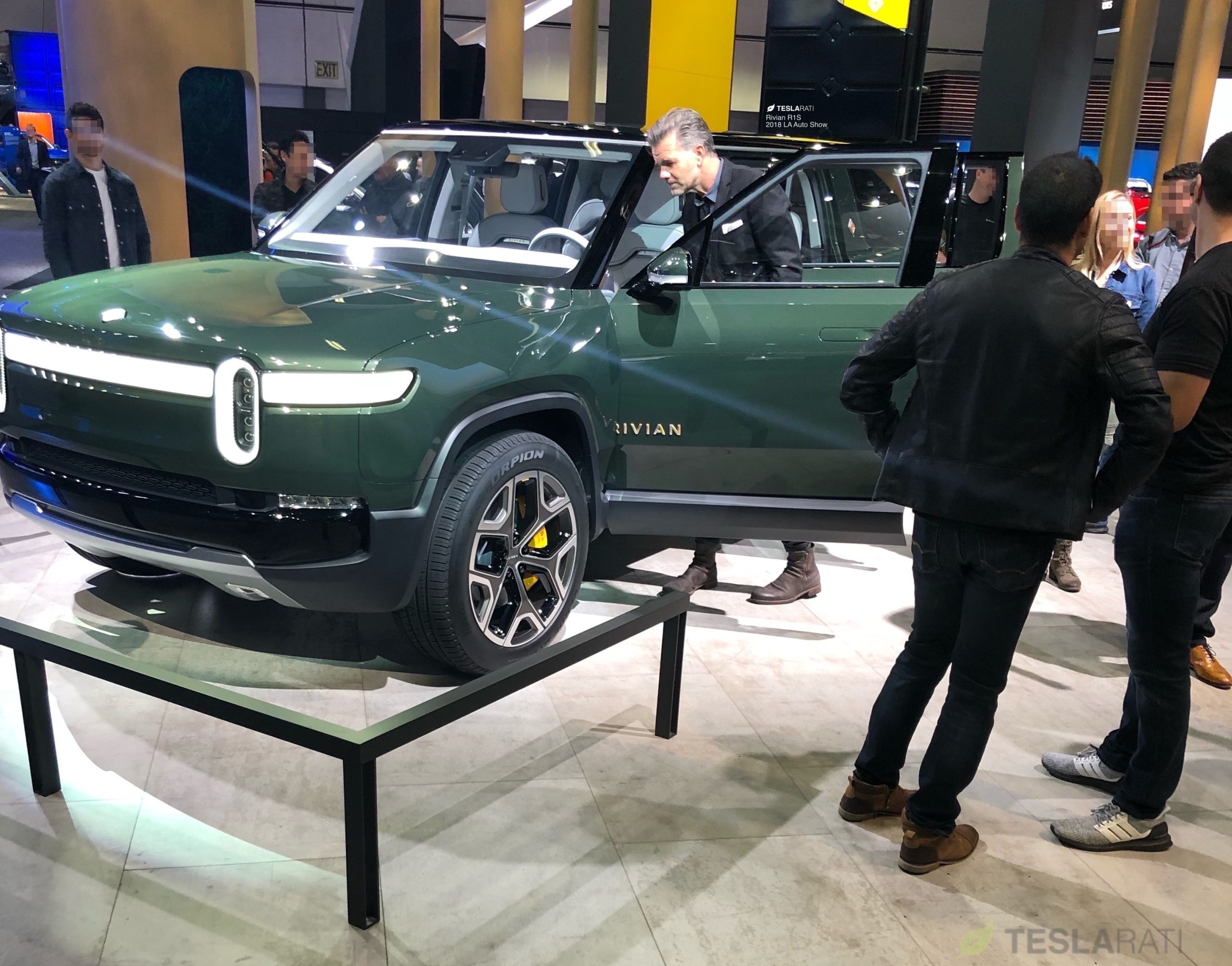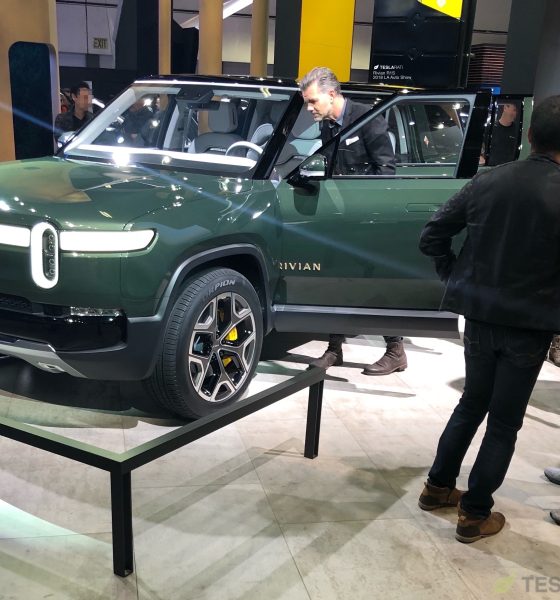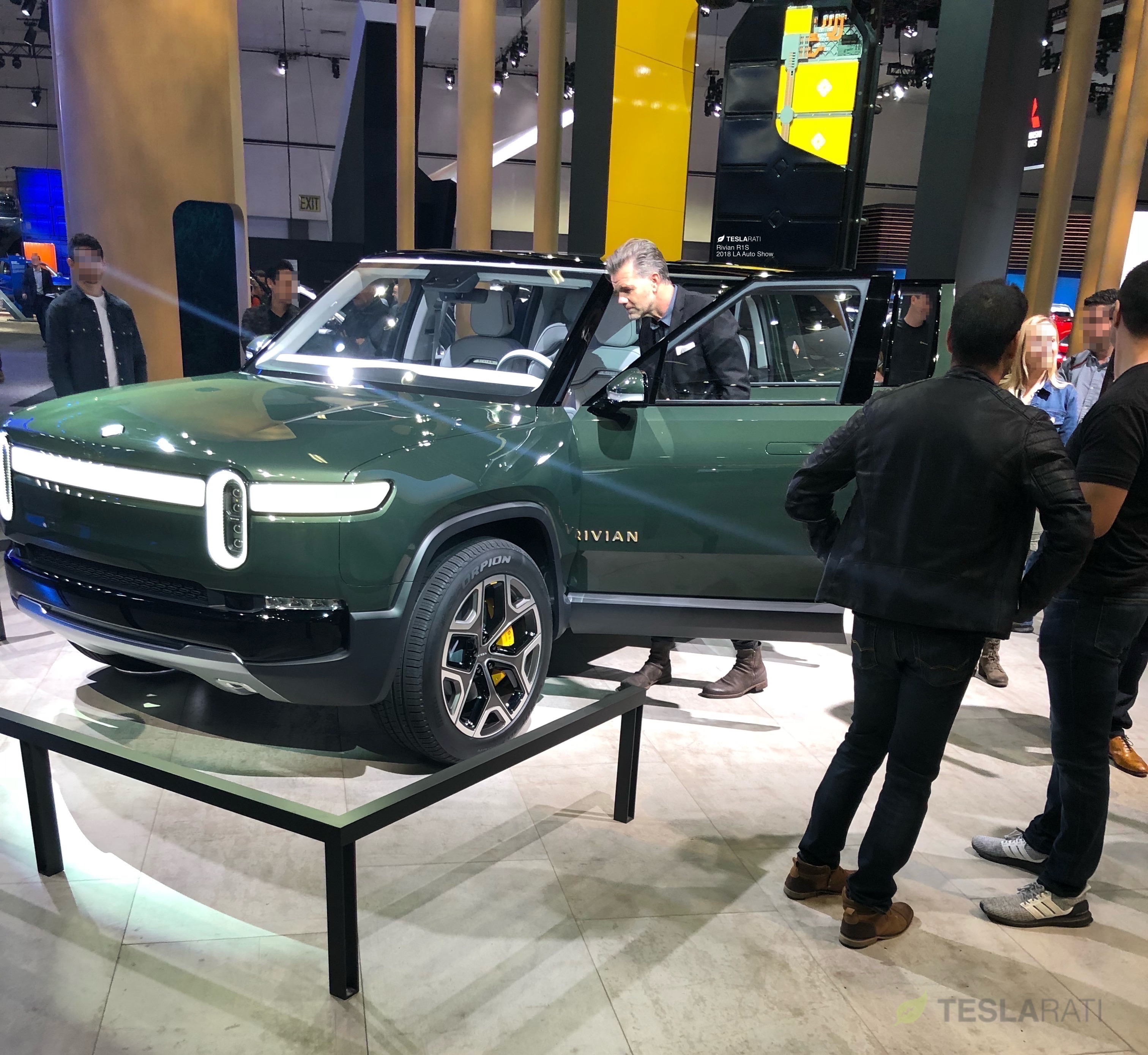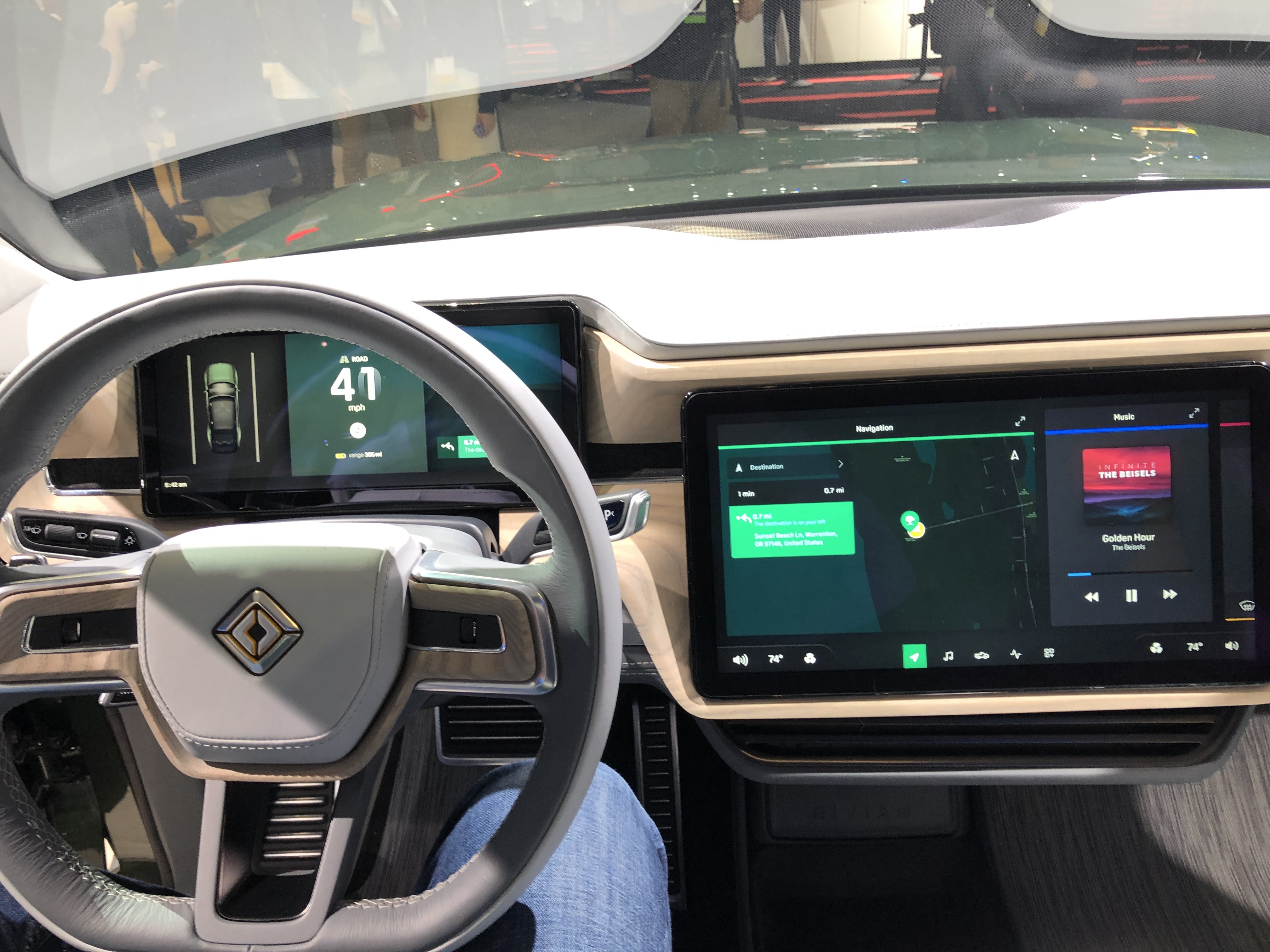

News
Rivian gets a surprise visit from Tesla Chief Designer Franz von Holzhausen
Rivian captured the attention of the automotive world when it debuted its quad-motor R1T all-electric pickup truck and R1S SUV in Los Angeles this week, including the attention of none other than Tesla Chief Designer Franz von Holzhausen.
Teslarati spotted the veteran automobile designer, and chief designer to the Tesla Model S, Model X, and Model 3, paying a surprise visit to Rivian’s LA Autoshow booth one day before the event is set to open its doors to the general public. Tesla also has a booth this year at the auto show where the company is showcasing its solar roof tiles, energy products, and its fleet of electric vehicles.
While Tesla executives including CEO Elon Musk have yet to make any public comments about Rivian’s launch, Von Holzhausen’s presence at their LA Autoshow booth and his visible interest in the R1S SUV can be interpreted as a sign that Tesla is taking the Michigan-based electric car startup seriously.
Tesla Chief Designer Franz von Holzhausen checks out Rivian’s new R1S SUV. (Photo: Teslarati)
Rivian’s R1S design was led by Jeff Hammoud, who joined Rivian in May of 2017 as VP of Vehicle Design. Hammoud previously spent 13 years at Fiat Chrysler, where he was Chief of Design for the Jeep division. His most notable design during his tenure with Jeep was the Jeep Grand Cherokee. In addition to recruiting Hammoud from Jeep, Rivian also brought on Nick Malachowski as Director of Advanced Design.
“The R1T and R1S designs communicate strength and refinement while still inviting customers to get the vehicles dirty. Strong proportions and clean, continuous bodylines help achieve a modern, inviting stance while acknowledging the performance and level of technology integrated into the vehicles,” Rivian stated in a press release.
Details of the Rivian R1T and the Rivian R1S. (Credit: Christian Prenzler/Teslarati)
Although the design language between Tesla and Rivian may differ, Hammoud and Von Holzhausen both share in their passion to build and create something that would ordinarily just be a dream. And do so while being unbounded.
“The chance to be part of something like this from the ground up is the kind of opportunity you dream about,” Jeff Hammoud stated in a Rivian blog post.
“I’m looking forward to working at a new startup company that doesn’t have the confines of a large OEM,” Von Holzhausen told Car Design News when he joined Tesla in 2008.
Rivian’s R1S will go into production in the second half of 2020 and starts at $72,500. The R1S’s range is configurable between three battery pack variants: 105 kWh, 135 kWh, and 180 kWh, each providing 240, 310, and 410+ miles, respectively.

In addition to checking out Rivian’s SUV, Von Holzhausen also looked at Rivian’s R1T pickup truck that was also at the company booth. Rivian’s R1T is the first production electric truck to be revealed. Tesla is currently designing and developing their own electric pickup truck but has yet to disclose any information about its design, size, or pricing.
RELATED: Rivian R1T and R1S: Top 10 hidden features that make an electric off-road vehicle
The starting price for Rivian’s R1T begins at $69,000 and has the same battery pack configurations as the R1S. The company is expecting to produce roughly 50,000 of the R1T and R1S in their manufacturing plant in Normal, IL. Rivian has started to take preorders for both their vehicles with a $1,000 deposit.
Update: A spelling correction has been made to Rivian’s VP of Design, Jeff Hammoud.

News
Tesla FSD fleet is nearing 7 billion total miles, including 2.5 billion city miles
As can be seen on Tesla’s official FSD webpage, vehicles equipped with the system have now navigated over 6.99 billion miles.

Tesla’s Full Self-Driving (Supervised) fleet is closing in on almost 7 billion total miles driven, as per data posted by the company on its official FSD webpage.
These figures hint at the massive scale of data fueling Tesla’s rapid FSD improvements, which have been quite notable as of late.
FSD mileage milestones
As can be seen on Tesla’s official FSD webpage, vehicles equipped with the system have now navigated over 6.99 billion miles. Tesla owner and avid FSD tester Whole Mars Catalog also shared a screenshot indicating that from the nearly 7 billion miles traveled by the FSD fleet, more than 2.5 billion miles were driven inside cities.
City miles are particularly valuable for complex urban scenarios like unprotected turns, pedestrian interactions, and traffic lights. This is also the difference-maker for FSD, as only complex solutions, such as Waymo’s self-driving taxis, operate similarly on inner-city streets. And even then, incidents such as the San Francisco blackouts have proven challenging for sensor-rich vehicles like Waymos.
Tesla’s data edge
Tesla has a number of advantages in the autonomous vehicle sector, one of which is the size of its fleet and the number of vehicles training FSD on real-world roads. Tesla’s nearly 7 billion FSD miles then allow the company to roll out updates that make its vehicles behave like they are being driven by experienced drivers, even if they are operating on their own.
So notable are Tesla’s improvements to FSD that NVIDIA Director of Robotics Jim Fan, after experiencing FSD v14, noted that the system is the first AI that passes what he described as a “Physical Turing Test.”
“Despite knowing exactly how robot learning works, I still find it magical watching the steering wheel turn by itself. First it feels surreal, next it becomes routine. Then, like the smartphone, taking it away actively hurts. This is how humanity gets rewired and glued to god-like technologies,” Fan wrote in a post on X.
News
Tesla starts showing how FSD will change lives in Europe
Local officials tested the system on narrow country roads and were impressed by FSD’s smooth, human-like driving, with some calling the service a game-changer for everyday life in areas that are far from urban centers.

Tesla has launched Europe’s first public shuttle service using Full Self-Driving (Supervised) in the rural Eifelkreis Bitburg-Prüm region of Germany, demonstrating how the technology can restore independence and mobility for people who struggle with limited transport options.
Local officials tested the system on narrow country roads and were impressed by FSD’s smooth, human-like driving, with some calling the service a game-changer for everyday life in areas that are far from urban centers.
Officials see real impact on rural residents
Arzfeld Mayor Johannes Kuhl and District Administrator Andreas Kruppert personally tested the Tesla shuttle service. This allowed them to see just how well FSD navigated winding lanes and rural roads confidently. Kruppert said, “Autonomous driving sounds like science fiction to many, but we simply see here that it works totally well in rural regions too.” Kuhl, for his part, also noted that FSD “feels like a very experienced driver.”
The pilot complements the area’s “Citizen Bus” program, which provides on-demand rides for elderly residents who can no longer drive themselves. Tesla Europe shared a video of a demonstration of the service, highlighting how FSD gives people their freedom back, even in places where public transport is not as prevalent.
What the Ministry for Economic Affairs and Transport says
Rhineland-Palatinate’s Minister Daniela Schmitt supported the project, praising the collaboration that made this “first of its kind in Europe” possible. As per the ministry, the rural rollout for the service shows FSD’s potential beyond major cities, and it delivers tangible benefits like grocery runs, doctor visits, and social connections for isolated residents.
“Reliable and flexible mobility is especially vital in rural areas. With the launch of a shuttle service using self-driving vehicles (FSD supervised) by Tesla in the Eifelkreis Bitburg-Prüm, an innovative pilot project is now getting underway that complements local community bus services. It is the first project of its kind in Europe.
“The result is a real gain for rural mobility: greater accessibility, more flexibility and tangible benefits for everyday life. A strong signal for innovation, cooperation and future-oriented mobility beyond urban centers,” the ministry wrote in a LinkedIn post.
News
Tesla China quietly posts Robotaxi-related job listing
Tesla China is currently seeking a Low Voltage Electrical Engineer to work on circuit board design for the company’s autonomous vehicles.

Tesla has posted a new job listing in Shanghai explicitly tied to its Robotaxi program, fueling speculation that the company is preparing to launch its dedicated autonomous ride-hailing service in China.
As noted in the listing, Tesla China is currently seeking a Low Voltage Electrical Engineer to work on circuit board design for the company’s autonomous vehicles.
Robotaxi-specific role
The listing, which was shared on social media platform X by industry watcher @tslaming, suggested that Tesla China is looking to fill the role urgently. The job listing itself specifically mentions that the person hired for the role will be working on the Low Voltage Hardware team, which would design the circuit boards that would serve as the nervous system of the Robotaxi.
Key tasks for the role, as indicated in the job listing, include collaboration with PCB layout, firmware, mechanical, program management, and validation teams, among other responsibilities. The role is based in Shanghai.
China Robotaxi launch
China represents a massive potential market for robotaxis, with its dense urban centers and supportive policies in select cities. Tesla has limited permission to roll out FSD in the country, though despite this, its vehicles have been hailed as among the best in the market when it comes to autonomous features. So far, at least, it appears that China supports Tesla’s FSD and Robotaxi rollout.
This was hinted at in November, when Tesla brought the Cybercab to the 8th China International Import Expo (CIIE) in Shanghai, marking the first time that the autonomous two-seater was brought to the Asia-Pacific region. The vehicle, despite not having a release date in China, received a significant amount of interest among the event’s attendees.








